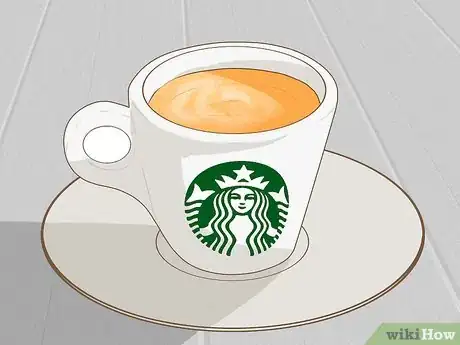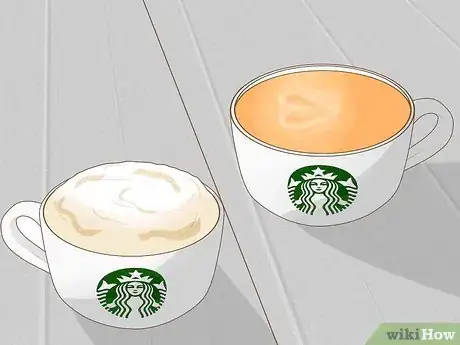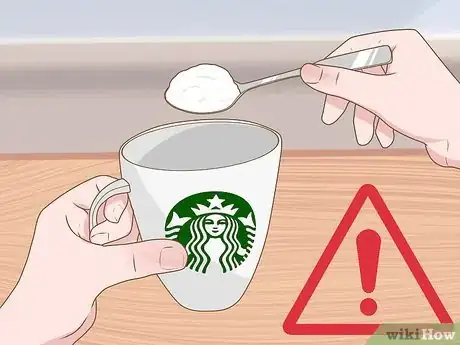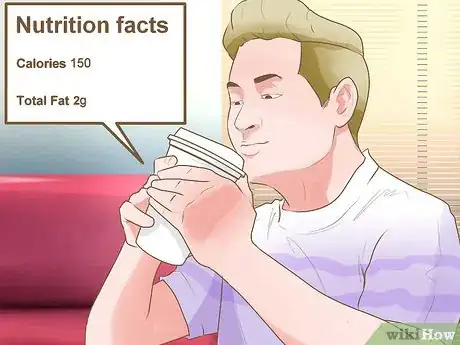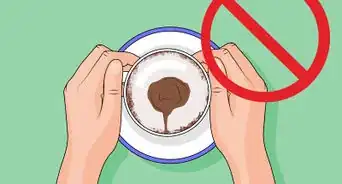This article was co-authored by Melody Sayers, MS, RD, NASM-CPT. Melody Sayers is a Registered Dietitian and NASM (National Academy of Sports Medicine) Certified Personal Trainer. She is the owner of Elevate Your Plate®, a private nutrition counseling and personal training practice, focused on an evidence-based, individualized, realistic, and results-driven approach to improving one's health. With over 8 years of experience, Melody has worked in both the private and public health sectors, helping both individuals and communities achieve milestones in managing their weight and preventing disease. She currently holds a Certificate in Adult Weight Management and a Master of Science in Nutrition, Dietetics, and Food Science from the California State University - Northridge.
There are 8 references cited in this article, which can be found at the bottom of the page.
This article has been viewed 32,731 times.
Does your morning include a stop at Starbucks? Have you ever wondered how to make a healthy and low-calorie choice when faced with the menu’s dizzying variety of coffee drinks? To find a good option, you’ll want to learn how to identify healthy beverages and customize your coffee, but also learn how to interpret nutritional labels and make good comparative choices.
Steps
Choosing Healthier Drinks
-
1Go with plain brewed coffee. Coffee isn’t just delicious; it’s also one of the healthiest drinks in the world apart from water. It is nearly calorie-free and filled with antioxidants, flavonoids, and other nutrients. The thing is, we tend to add all sorts of extras that inflate coffee’s calorie count and turn it into a nutritional pitfall.[1]
- Plain coffee has almost no calories. To make a healthier choice, order a basic cup of joe and limit the added calories that come in sugar and fat. These usually come from things like sugar packets, syrup, cream, whipped cream, or toppings.[2]
- Order whatever size you like. The great thing about plain coffee is that you can have a large serving without a huge calorie count. A short black coffee (the smallest size) has 3 calories; a venti (the largest size) has 5.
-
2Do like the Italians with a shot of espresso. Espresso was pioneered in Italy. It’s is a kind of coffee that’s brewed by forcing boiling water through finely ground coffee beans and makes a strong, concentrated brew topped with foam or “crema.” While espresso forms the base of other coffee beverages like caffe latte, caffe macchiato, and cappuccino, when served plain it tastes great and is low in calories.
- Order a single or double shot of plain espresso, or in Starbucks terms a “solo” or “doppio.” The first has 5 calories and the second 10. Be prepared for small portions sizes, however, as the shots will be smaller than your normal cup of brewed coffee.
- Caffe Americano is plain espresso, too, made by adding extra hot water to a single or double shot of espresso. It has a few more calories than brewed coffee (5 for a short, 25 for venti), but is still a good option.
Advertisement -
3Get a cappuccino or regular latte for a treat. As far as “enhanced” coffees go, cappuccino and lattes fare well enough to be a treat if you want to order something special. Cappuccino is made by adding hot water and steamed milk foam to plain espresso. A latte is also espresso but with added steamed milk and a bit of foam on top.
- A short cappuccino with regular milk has about 80 calories, which drops to 50 if you opt for non-fat or soy milk. A venti has 110, 120, and 150 calories for non-fat, soy, and regular milk. The calorie count and portion size is a bit smaller than caffe latte but with no lost flavor.
- Lattes have more calories, as they contain more milk and thus more sugar: a short has 100 calories with regular milk and 70 with nonfat or soy milk. A venti has 240, 170, and 190, respectively.
- Limit the amount of sugar that you add to your cappuccino and latte, because this will increase the calorie and sugar content. Instead, sprinkle some cinnamon or nutmeg on top. These spices are also very low in calories.
-
4Avoid drinks with extra adjectives. One good rule of thumb at Starbucks is to stay clear of drinks that have long names with extra adjectives. Beverages with “Mocha,” “Vanilla,” “Caramel,” “White Chocolate,” or “Caramel Apple Spice” in the title all sound delicious but promise added sugar, fat, and calories from flavorings and sweeteners. It’s safe to assume that they are a less healthy choice.
- Take a caramel macchiato, for example. The venti size comes to 240 and 250 calories with nonfat and soy milk and 300 with regular milk — the equivalent of a good-sized snack. These calories come almost entirely from added sweeteners.
- The caffe mocha without whipped cream is even worse. A short contains 110 calories with nonfat and soy milk and 130 calories with regular milk; a venti has 280, 290, and 340 calories. Most of these extra calories come from added sugar.
Customizing Your Coffee
-
1Order a short. Keep in mind a basic rule when ordering coffee at Starbucks: bigger is not better, especially if you are watching calories. A venti often has double or even triple the amount of sugar, fat, and calories that a short does. Middle sizes like tall and grande fare a bit better but will still bump up your total count by 40 to 60 calories. [3]
- Opt for a short caffe latte over a venti, for example. You’ll get between 70 to 100 calories rather than between 170 to 240.
- The same goes for the terribly unhealthy White Chocolate Mocha. A short is between 180 to 200 calories, while a venti is the equivalent of a meal: 450 to 510 calories.
- The only exception to the size rule is regular brewed coffee, which is almost entirely calorie-free when it’s black. Just limit the amount of milk or sugar you add.
-
2Ask for no fat milk or soy milk alternatives.[4] Many people like milk in their coffee to enhance the taste or because they dislike coffee’s naturally bitter flavor. The milk cuts the bitterness and also give the drink a rich taste; however, milk adds fat and sugar to the beverage. If you can’t take your coffee black, at least ask for low-fat and low-calories alternatives.[5] [6]
- Consider that a tall cappuccino with non-fat milk is only 60 calories, while the same size with regular milk is 90 calories. That’s a “savings” of 30 calories.
- Some Starbucks beverages are only made with low-calorie milks. The “skinny latte” is a great alternative to the classic caffe latte and only uses non-fat milk, for example, as does the Frappuccino Light Blend.
- Both of these nonfat milk alternatives have lower calories counts across the board. A short skinny latte is 60 calories, compared to 100 in a short, regular caffe latte. A tall Frappuccino Light is 90 calories, compared to 180 in the regular blend.
-
3Limit extra sugar and syrups.[7] Another big source of calories at Starbucks is added sugar from things like flavor syrups. These go into many of the specialized coffee beverages and tack on dozens of grams of sugar and sometimes hundreds of extra calories. You can better limit your calorie count by asking the barista for a sugar-free syrup or to even go without it.[8] [9] [10]
- Starbucks offers the option of sugar-free flavor syrup when you customize your coffee, for example. Opt for this over the normal flavor syrup. You can also request sugar substitutes, like packets of Splenda instead of cane sugar.
- Better yet, choose a beverage that doesn’t need syrup at all. Starbucks usually adds syrup to iced coffee beverages, for example, but these drinks can be just as refreshing and tasty with nonfat or soy milk and no added sugar.
- Consider the sugar content of some of these drinks: a venti iced brewed coffee (with milk and syrup) has between 33 and 36 grams of sugar. That’s about a day’s worth of your recommended sugar intake. The venti Frappuccino has between 66 and 69 grams.
Comparing Beverages
-
1Learn to count calories. For choosing a healthy coffee drink, it helps to be able to find your way through nutritional labels in general. These labels can seem daunting, but they’re actually pretty easy to use once you know what to look for. For coffee, you’ll want to focus on three major items: calories, fat, and sugar. [11]
- Calories are your biggest concern, since they are what gives you energy and can lead to weight loss or gain. More calories over time tends to lead to weight gain, while fewer help you lose or maintain weight.
- Look for calories to be featured prominently. Often, the label will tell you how much the whole drink contains; however, it sometimes isn’t so straightforward and requires a bit of math.
- Some labels will tell you the “serving size,” say 100 calories per serving. This does not necessarily mean the drink has 100 calories. Make sure to check how many servings the drink contains, too. If a drink has 2.5 servings, you’ll need to multiply 2.5 by the calories per serving of 100. This means your drink has 250 calories in all.
-
2Look for fat and sugar content, as well. The two other culprits in coffee drinks are fat and sugar, which come from things like milk, flavored syrup, whipped cream, toppings, or other sugars like honey. As a general rule, all of these extras will add calories to your beverage without adding to the nutritional value. Look for the total content of these ingredients, too.[12]
- Fat is usually listed early on in nutritional labels. In coffee drinks, most of the fat content comes from milk, whipped cream, or sometimes chocolate.
- A healthy coffee beverage shouldn’t have more than 2 or 3 grams of fat.
- Remember to multiply fat, if need be. For instance, a drink that has 4 grams of fat per serving might be OK; however, if that drink also contains three servings, the total fat content is a high 12 grams.
-
3Check Starbuck’s nutritional information online. Unfortunately, not all Starbucks stores offer nutritional information and calorie counts in-store, though they ran a pilot program in 2008 and posting this information actually led to fewer calories per transaction. Still, the company posts some nutritional content online. Check their website to access charts and information.[13]
- Keep in mind that Starbuck’s online data doesn’t feature seasonal drinks, like their speciality Holiday coffee beverages.
- You can also ask your barista about the calorie, fat, and sugar content of specific drinks or even call the company’s customer service line directly at 1-800-23LATTE (1-800-235-2883).
Expert Q&A
-
QuestionHow can I get drinks with lower calories from Starbucks?
 Melody Sayers, MS, RD, NASM-CPTMelody Sayers is a Registered Dietitian and NASM (National Academy of Sports Medicine) Certified Personal Trainer. She is the owner of Elevate Your Plate®, a private nutrition counseling and personal training practice, focused on an evidence-based, individualized, realistic, and results-driven approach to improving one's health. With over 8 years of experience, Melody has worked in both the private and public health sectors, helping both individuals and communities achieve milestones in managing their weight and preventing disease. She currently holds a Certificate in Adult Weight Management and a Master of Science in Nutrition, Dietetics, and Food Science from the California State University - Northridge.
Melody Sayers, MS, RD, NASM-CPTMelody Sayers is a Registered Dietitian and NASM (National Academy of Sports Medicine) Certified Personal Trainer. She is the owner of Elevate Your Plate®, a private nutrition counseling and personal training practice, focused on an evidence-based, individualized, realistic, and results-driven approach to improving one's health. With over 8 years of experience, Melody has worked in both the private and public health sectors, helping both individuals and communities achieve milestones in managing their weight and preventing disease. She currently holds a Certificate in Adult Weight Management and a Master of Science in Nutrition, Dietetics, and Food Science from the California State University - Northridge.
Registered Dietician & Personal Trainer Try to avoid drinks that have whipped cream, whole milk, or additional sweeteners since they'll all add more calories.
Try to avoid drinks that have whipped cream, whole milk, or additional sweeteners since they'll all add more calories. -
QuestionIs Starbucks coffee bad for your health?
 Melody Sayers, MS, RD, NASM-CPTMelody Sayers is a Registered Dietitian and NASM (National Academy of Sports Medicine) Certified Personal Trainer. She is the owner of Elevate Your Plate®, a private nutrition counseling and personal training practice, focused on an evidence-based, individualized, realistic, and results-driven approach to improving one's health. With over 8 years of experience, Melody has worked in both the private and public health sectors, helping both individuals and communities achieve milestones in managing their weight and preventing disease. She currently holds a Certificate in Adult Weight Management and a Master of Science in Nutrition, Dietetics, and Food Science from the California State University - Northridge.
Melody Sayers, MS, RD, NASM-CPTMelody Sayers is a Registered Dietitian and NASM (National Academy of Sports Medicine) Certified Personal Trainer. She is the owner of Elevate Your Plate®, a private nutrition counseling and personal training practice, focused on an evidence-based, individualized, realistic, and results-driven approach to improving one's health. With over 8 years of experience, Melody has worked in both the private and public health sectors, helping both individuals and communities achieve milestones in managing their weight and preventing disease. She currently holds a Certificate in Adult Weight Management and a Master of Science in Nutrition, Dietetics, and Food Science from the California State University - Northridge.
Registered Dietician & Personal Trainer Coffee itself is very low in calories. It's all of the extras that can make your drink high in calories, sugar, and fat. Stick to basic coffee without a lot of add-ins to save on calories.
Coffee itself is very low in calories. It's all of the extras that can make your drink high in calories, sugar, and fat. Stick to basic coffee without a lot of add-ins to save on calories.
Warnings
- Liquid calories are less satisfying than solid foods, and do not suppress hunger. So it is easy to consume a high calorie coffee, and not have satiety.⧼thumbs_response⧽
References
- ↑ http://www.hsph.harvard.edu/nutritionsource/healthy-drinks-full-story/
- ↑ Melody Sayers, MS, RD, NASM-CPT. Registered Dietician & Personal Trainer. Expert Interview. 6 May 2020.
- ↑ http://www.cdc.gov/healthyweight/healthy_eating/drinks.html
- ↑ Melody Sayers, MS, RD, NASM-CPT. Registered Dietician & Personal Trainer. Expert Interview. 6 May 2020.
- ↑ http://www.berkeleywellness.com/healthy-eating/food/slideshow/healthy-alternatives-cows-milk
- ↑ http://www.cdc.gov/healthyweight/healthy_eating/drinks.html
- ↑ Melody Sayers, MS, RD, NASM-CPT. Registered Dietician & Personal Trainer. Expert Interview. 6 May 2020.
- ↑ https://spoonuniversity.com/how-to/how-to-order-at-starbucks-when-you-want-to-be-healthy/
- ↑ http://customerservice.starbucks.com/app/answers/detail/a_id/1960/session/L3RpbWUvMTQ2Mjk3NDc2MS9zaWQvQzhuYldkUW0%3D
- ↑ http://www.mayoclinic.org/healthy-lifestyle/nutrition-and-healthy-eating/in-depth/added-sugar/art-20045328
- ↑ http://www.cdc.gov/healthyweight/healthy_eating/drinks.html
- ↑ http://www.cdc.gov/healthyweight/healthy_eating/drinks.html
- ↑ https://www.gsb.stanford.edu/insights/researchers-how-does-posting-calories-affect-behavior


